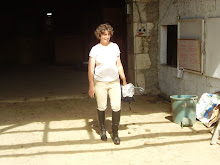Once students have acquired enough vocabulary that they can read short texts with ease and pleasure, it's time to start thinking about reading a novel with them. There are simple TPRS novels which use a very limited vocabulary. I admire the people who create them because I myself could never accept the limitations of writing a complete novel using only 200 words. Sometimes even fewer. And I have never tried to use one of their novels with a class, simply because I have learned in the past that if the material bores me, I'm completely incapable of making it interesting for my students. I may be wrong. I probably am wrong because there are many teachers who use the limited vocabulary books written especially for language learners and have fun doing it.
Personally, I prefer to go to films at that point and use the subtitles as a written text. After my students have worked through two or three films, they usually have enough confidence that they start watching films in English with English subtitles on their own, and I know the battle is won, that they are now autonomous.
Yet I know that their progress will be faster if they are reading in English for their own pleasure. And I have a few students whose spoken English is excellent but whose written English, while basically correct, is very disappointing. So I've been trying to find a novel that I can read with them. And I remembered a simple little book that I read in a book club some time ago that I enjoyed immensely. Holes was written by Lous Sachar and is a captivating fable set in modern day Texas. I began using it with a boy who is bright and even gifted, but simply has never learned to read for his own pleasure. He is enjoying the story and occasionally reads ahead to find out what's going to happen. I've already ordered another book by Louis Sachar for him.
So I ordered more copies of the book from Amazon.uk where it's very cheap and started reading it with a group of adults. They were immediately hooked by the story and I'm now using it with three groups in all. My goal is to show them that with minimum assistance from me they can read a complete novel in English. I want to be able to cover at least a chapter an hour and not to draw the activity out too long. I'm hoping that as we progress, they'll be able to read one or more chapters on their own.
Louis Sachar's style is simple but not dumbed down. His heroes are young boys and he uses language they could use but his narrator avoids slang. A typical page of text contains about twelve words that my students might not know. A typical chapter is four-five pages long. Some are much shorter.
Before the lesson I write down the words or expressions that I think may be difficult for my students. I group them by page, in the order they are found and highlight in red the ones that are high frequency. Before reading the first page, we go over the 12 words and I give them a quick definition or explanation for each one. I do a bit of circling and PQA with the high frequency words and ask if they have any special interest or associations with the others. Usually there are not more than three or four high-frequency words on a page and I explain that I don't consider the others very important, unless they're of interest to the students for a particular reason.
We then begin reading the text, translating as we read. Each student does a sentence, but if there is anything difficult in it, I step in and help them over the hard places. As we go, we discuss the situation and the characters in English. I often ask them what they expect to happen next or what they think of the characters, and of course on the very next page they discover that things are not what they seem. This is Louis Sachar's charm. His story never goes where it seems to be going. The first chapter is entitled Camp Green Lake. The first sentence of the chapter is: There is no lake at Camp Green Lake. That sets the tone for the rest of the story where nobody is what they first seem to be.
It would be possible to use Embedded texts with the novel, but I'm afraid that reading three texts instead of one would slow us down and make the activity too laborious. My goal is to make reading in English a pleasant activity so that they will want to continue reading other books on their own. I'm not insisting that they acquire all the words we see. If a word is high frequency we'll be seeing it again and again and again, and it will eventually be acquired. If it's not high frequency, it doesn't matter. Basically, I'm doing what Susie Gross called "reading lickety-split." So far the students are loving it and I'm having fun seeing them grapple successfully with a good book that was not written specifically for language learners.
Friday, October 25, 2013
Subscribe to:
Posts (Atom)
